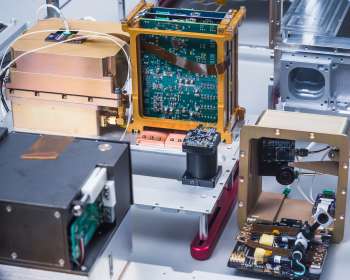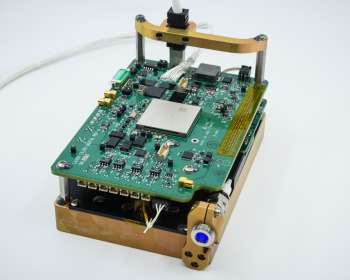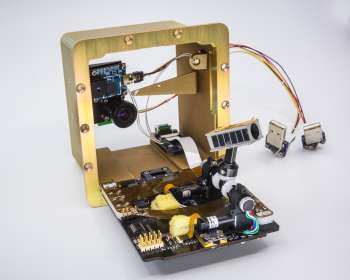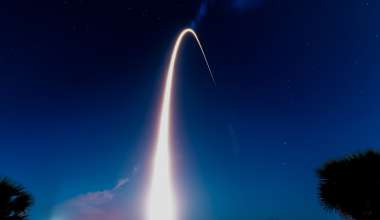The Aerospace Corporation’s Slingshot 1 mission is successfully demonstrating the potential for modular technologies to improve the flexibility of satellites and expedite the integration timeline for payloads. The 12-unit Slingshot 1 CubeSat enabled a variety of experiments across 19 different payloads by connecting them to the satellite bus using a simplified “plug-and-play” interface, demonstrating the use of open standards and non-proprietary interfaces for on-orbit experiments.
The ability to quickly design, build, and deliver advanced prototypes was a key focus of Aerospace’s Slingshot 1 mission, highlighting the possibilities for rapid prototyping facilitated by streamlined payload provisioning. With its one-year mission now fulfilled, Slingshot 1 has now started an extended operations period to complete some experiments and provide continued service for customers.

“The journey from a concept, to forming a team that will build it to spaceflight standards using established processes and then testing it is usually a long road,” said David Hinkley, Senior Project Leader at Aerospace’s xLab. “Rapid prototyping paid off for Slingshot 1 in a big way, and not just by reducing turnaround time. The standard bus interface brought down the cost per payload, allowing a greater number of experiments on this mission. The experience gained by the payload engineers is valuable to future endeavors as payload developers or advisors to the government.”
All payloads onboard Slingshot were connected to a SatCat5 open-source Ethernet switch contained in the “Handle” payload, which served as the electrical interface module that enabled the flow of data and power from the host satellite bus to the other payloads. All payloads on Slingshot 1 – of which 16 are self-funded by Aerospace – were designed to be self-contained and upgradeable. The technologies onboard advance a broad range of capabilities, including autonomy, propulsion, robotics, onboard processing, and communications systems. All these technologies are critical to strengthening capabilities for future space architecture and systems.
Enabling Rapid Innovation for the Future
In addition to demonstrating the benefits of adopting the modular concept for a small satellite platform, the payloads onboard Slingshot 1 achieved notable milestones, collected meaningful mission data, and advanced new capabilities while in orbit. These milestones demonstrate the potential for Aerospace’s modular approach to enhance speed and agility for space missions, allowing for rapid innovation, broader experimentation, and faster maturation of space capabilities.
“Slingshot 1 was a technology demonstration mission featuring experiments from a broad range of areas,” said Hinkley. “When you have a deliberately seamless payload interface that’s easy to use, it's not a big stretch to put many different experiments on there. This creates opportunities for the evolution and maturation of space-based technology.”
Payloads in Spotlight
The Slingshot bus hosted a number of payloads, enabling a breadth of innovative experiments and technology maturation, such as with Lasercomm for optical communications and ExoRomper for imaging experiments. Lasercomm contains a compact, highly efficient 4-watt laser transmitter for space-to-ground optical communication. The updated laser module incorporates a revised output collimator and new optical monitor for health and status monitoring of the laser. The Lasercomm payload was developed to advance Aerospace’s in-house technology and to assess the attitude-control capability of a vendor-supplied spacecraft.

During preliminary testing, Lasercomm successfully downlinked data to Aerospace ground stations at 250 Mbps. Pointing was observed to be very stable. These results indicated that data rates approaching 10 Gbps would be achievable with this laser platform/bus combination following the insertion of updated laser hardware already developed at Aerospace.
Aerospace developed an approach that enabled the vendor to determine the alignment between the laser emission and the bus star tracker fields of view prior to launch. This information streamlines on-orbit pointing calibration. Additionally, Lasercomm served as a test source for optical ground stations under development by US allied partners. Specifically, downlinks to ground stations in Spain and Australia were conducted.
Meanwhile, the ExoRomper payload is a reprogrammable machine vision testbed designed to test satellite pose estimation algorithms and best practices for machine learning (ML) operations in a low Earth orbit (LEO) environment. ExoRomper used visible and infrared cameras pointed at a maneuverable miniature spacecraft to capture images of the spacecraft in a variety of positions and poses. It then used the Google Coral processor to process the images onboard and estimate the spacecraft's pose using ML and Perspective-N-Point algorithms.

Since the payload's deployment, the ExoRomper team has successfully deployed a first revision of the satellite pose estimation software, captured more than 1,000 operational images across a variety of lighting conditions, and used those operational images to train new ML models on the ground. The ExoRomper team used the payload's software re-programmability feature to update the pose estimation software with the newly trained ML models, improving the accuracy of the pose estimation and raising the technology’s readiness level.
Multiple Payloads, Countless Possibilities
Lasercomm and ExoRomper are just two of the payloads aboard Slingshot 1 that are advancing modern technologies. Other payloads include the low-power ethernet switch SatCat5, C-band transmitter ACETaTE, sensor-to-processor coordinator ROESA, communications downlink SDR2.0, and the imaging system t.Spoon camera. Additional information about these payloads and the Aerospace experts who worked on them is available in the video below.
The Future is Modular
With the success of Slingshot 1, Aerospace is advancing the state-of-the-art by contributing to the development and evolution of critical satellite technologies, such as advanced sensors, onboard processing, cislunar technologies, and space robotics. With the goals of the original mission achieved, Slingshot 1 will continue to live on as it transitions to support an Aerospace government customer program.
“Now that Slingshot has completed its primary missions, we can perform new cyber tests that weren’t feasible while it had other missions to perform,” said Nicholas Cohen, Principal Engineer/Scientist in Aerospace’s Cybersecurity and Advanced Platforms department. “There will be opportunities for collaboration with academia and other FFRDCs, and we’ll be able to use the knowledge we gain to better defend our nation’s crucial space assets.”
Accelerating and expanding possibilities for access to space enables our nation’s space programs to stay ahead. The Slingshot platform’s modular approach, which embraces open standards and autonomous technologies, lays a compelling framework for accelerating innovation for this new era of space.
“Slingshot will continue to keep Aerospace at the leading edge of space science,” Cohen said. “It’s a fantastic opportunity for the government to get a cyber experimentation platform at a fraction of the cost of building and launching their own.”







